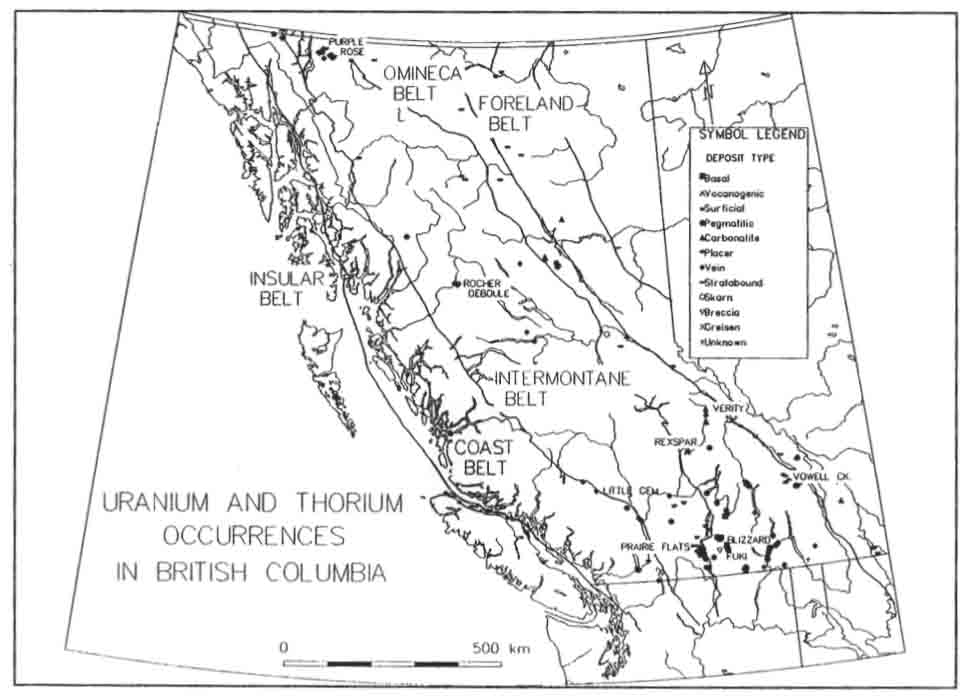Canada produces about one-third of the world’s uranium, which is used in nuclear power plants to produce electricity.
British Columbia
Uranium and Thorium occurrences in BC
Oliver, Revelstoke, Grand Forks
“The Grand Forks – Nelson area contains the largest concentration of radioactive pegmatite occurrences in British Columbia ” pg 21
Keep BC Nuclear Free
Stop Uranium Mining by John Moelaert
Plans to mine uranium in B.C. were first revealed in 1977. Public opposition grew very quickly. In response the Government of B.C. in September, 1978, ordered the formation of the Royal Commission of Inquiry into Uranium Mining. Evidence presented to the commission made it increasingly clear that uranium exploration, mining and milling pose major health and environmental risks. On February 27, 1980, the government ordered the early termination of the commission and the start of a seven-year moratorium on uranium exploration and mining. The ban was not renewed when it expired in 1987. This pamphlet was produced to show why the uranium ban should be reimposed.
http://www.boundaryalliance.org/mole.pdf
Uranium mine lawsuit costs B.C. $30M
CBC News Posted: Oct 21, 2011
The B.C. government has agreed to pay a mining company more than $30 million after it halted a uranium mining proposal near Kelowna in 2008 — and the NDP mining critic is blaming Liberal incompetence and interference for the costly settlement.
NDP energy critic John Horgan says the government was forced to settle with the company after Kevin Krueger, who was minister of state for mining at the time, issued a ban on uranium mining shortly after Boss Energy filed for permits for its Blizzard deposit.
read more : http://www.cbc.ca/news/canada/british-columbia/uranium-mine-lawsuit-costs-b-c-30m-1.1074501
Northwest Territories / Nunuvit
Village of Widows
Aired on Vision TV
Michele LeTourneau
Northern News Services
NNSL (Feb 22/99) – The story goes something like this: Many years ago there existed the world’s first uranium mine. It was located on Great Bear Lake in the Northwest Territories. Many Sahtu Dene men worked for the mine, transporting uranium ore in gunnysacks on their backs.
Many years later, all but a handful have died of cancer.
Village of Widows — a documentary by Peter Blow airing on Vision TV at 9 p.m. ET/PT, Wednesday, Feb. 24 — tells the ultimately unnerving story of the Sahtu Dene.
As Blow himself notes, this is not an investigative or journalistic effort.
“I wanted to make an intimate film from the perspective of the community,” writes Blow. This he does.
You see, the story is a little more complicated than I first implied. The film is about much more than a mine.
As Blow explains, members of the Deline Uranium Committee invited him to make a film about the Sahtu Dene’s “tragic involvement with the world’s first atomic bombs.”
In the film, it is explained that the Canadian government ran the mine on the shores of Great Bear Lake covertly, and sold the uranium exclusively to the United States atomic bomb program. Finally, that the uranium taken from Sahtu land was used in the bomb that fell on Hiroshima.
The film paints the picture of a sinister Canadian government, who years later, in 1996, reported that there were 1.7 million tonnes of radioactive waste (tailings) remaining on the mine site, in the lake, and in hot spots across the Sahtu lands.
Blow’s film is definitely effective. Interviews with elders are, in fact, sad litanies and frightening anecdotes. They speak of tents made with used gunnysacks dusty with uranium, children playing in “sandboxes” filled with tailings, of the decimation of entire families by cancer.
Further, Village of Widows records the link that was formed between the Sahtu Dene and the Japanese. Feeling unwittingly responsible and horrified that something taken from their lands was used to wreak such violent devastation on fellow humans, a group of Sahtu Dene made a pilgrimage to Japan.
Blow’s touch is sensitive and respectful, even gentle. The visual imagery, camerawork and editing are all at the service of the community’s desire to tell this story.
Archival footage locates the story in history, and as a viewer, I felt that I was witnessing the past as though it were happening now. I was horrified and angry. But it’s a confusing and deceptive experience. Though we now know some of the consequences of past decisions and actions, who can really say what was known then?
The by-now well-known image of the mushroom cloud slowly lifting and spreading over Hiroshima, placed in this context, seen from the eyes of the Sahtu Dene, takes on an especially surreal meaning. It defies human understanding.
Don’t watch this for an objective report on the ongoing debacle over what was once known as Port Radium. Rather, watch this as a bare revelation of the pain that haunts the community of Deline.
“What I’m really trying to say is that this production is probably the most special experience I’ve encountered in my 25 years working in the film industry,” writes Blow, who is a prolific and accomplished writer/director/producer based in Toronto.
“When people ask me how come a Brit living in Toronto feels so passionate about all this, I am reminded of a quote from a Navaho elder who eye-witnessed the first atomic bomb test in New Mexico, all those years ago. He gazed upon the devastation for a long time and then said, ‘Now the human race is one tribe again.'”
That is the passion that lends Village of Widows its intensity and power.
http://www.nnsl.com/frames/newspapers/1999-02/feb22_99vill.html
http://www.wise-uranium.org/udcdn.html
Published on May 31, 2016
Ontario
Lorraine Remans – Elliot Lake / Serpent River First Nation
#first nation #villageofwidows #uranium
